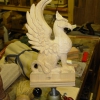Turning to the serifs next, there are 3 sorts in this font: full ones, halves and deltas.We'll add as many of these as we can at this stage.
We also finish off any junctions (A, M, N, V. W) and, after this stage, we'll see many letters completed!

| 13 February 2024 10:45
Understood, sir. Thanks 1,000x!

| 13 February 2024 09:36
Patrick - I never assume the angles of the bevels or quality of the cutting edge that arrive with the carving tool is what I want. They may well have been sharpened by someone who has never carved a bit of wood in their lives, and not the way I myself want to carved.
So, I always go through the process of commissioning them; and almost always this involves lowering the cutting angle or removing a micro-bevel.
It may well be that my chisels have a slightly rounded bevel; it's hard to avoid this once you start stropping and, as long as the cutting angles are low (15-20deg each side of the lettering chisels), it won't matter. But aim for as flat a bevel as you can, heel to edge.

| 13 February 2024 00:28
Chris, do you commission your lettering chisels in a particular way? In the videos, they seem to be set to a lower cutting angle than the manufacturer’s; similar to the way you commission certain gouges. They appear to be somewhat rounded, as well.
I just received a set of your lettering chisels. They are impressive!

| 11 December 2012 15:45
ABSOLUTELY INCREDIBLE Camera-work... We are spoiled "thanks"...

| 17 October 2012 12:55
Sandy - It's what I talk about in some detail here: Sharpening > Heel Corners. You are right in that this is a great example of where this modification is useful: the thinner corner gets into one half of the serif recess without fouling the opposite side.

| 17 October 2012 02:31
I believe this is the first instance where I have seen you use a fishtail gouge with the shoulders taken off. I often look closely at the particular tools you are using. I even pause the video to try to get a clearer view of how the chisel/gouge is shaped/sharpened to get a better grasp on it's particular use. This seems to be a wonderful example of why one would grind the shoulders off. I will defintiely be better aware of the uses of such a tool iin the future as I do carve some smaller signs for customers. And this appears to be valuable whether or not the lettering is large or small. Thanks so much, Sandy